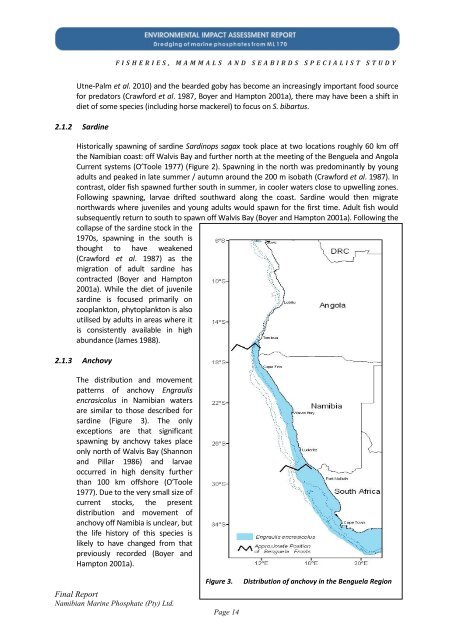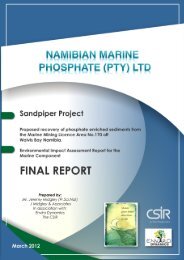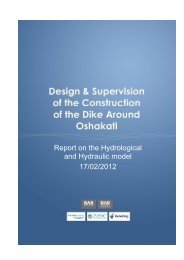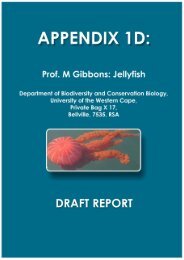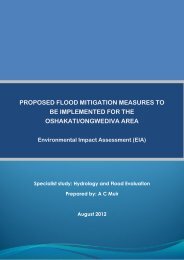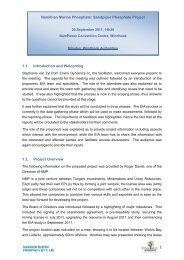Fisheries - Enviro Dynamics Namibia
Fisheries - Enviro Dynamics Namibia
Fisheries - Enviro Dynamics Namibia
Create successful ePaper yourself
Turn your PDF publications into a flip-book with our unique Google optimized e-Paper software.
F I S H E R I E S , M A M M A L S A N D S E A B I R D S S P E C I A L I S T S T U D Y<br />
Utne-Palm et al. 2010) and the bearded goby has become an increasingly important food source<br />
for predators (Crawford et al. 1987, Boyer and Hampton 2001a), there may have been a shift in<br />
diet of some species (including horse mackerel) to focus on S. bibartus.<br />
2.1.2 Sardine<br />
Historically spawning of sardine Sardinops sagax took place at two locations roughly 60 km off<br />
the <strong>Namibia</strong>n coast: off Walvis Bay and further north at the meeting of the Benguela and Angola<br />
Current systems (O’Toole 1977) (Figure 2). Spawning in the north was predominantly by young<br />
adults and peaked in late summer / autumn around the 200 m isobath (Crawford et al. 1987). In<br />
contrast, older fish spawned further south in summer, in cooler waters close to upwelling zones.<br />
Following spawning, larvae drifted southward along the coast. Sardine would then migrate<br />
northwards where juveniles and young adults would spawn for the first time. Adult fish would<br />
subsequently return to south to spawn off Walvis Bay (Boyer and Hampton 2001a). Following the<br />
collapse of the sardine stock in the<br />
1970s, spawning in the south is<br />
thought to have weakened<br />
(Crawford et al. 1987) as the<br />
migration of adult sardine has<br />
contracted (Boyer and Hampton<br />
2001a). While the diet of juvenile<br />
sardine is focused primarily on<br />
zooplankton, phytoplankton is also<br />
utilised by adults in areas where it<br />
is consistently available in high<br />
abundance (James 1988).<br />
2.1.3 Anchovy<br />
The distribution and movement<br />
patterns of anchovy Engraulis<br />
encrasicolus in <strong>Namibia</strong>n waters<br />
are similar to those described for<br />
sardine (Figure 3). The only<br />
exceptions are that significant<br />
spawning by anchovy takes place<br />
only north of Walvis Bay (Shannon<br />
and Pillar 1986) and larvae<br />
occurred in high density further<br />
than 100 km offshore (O’Toole<br />
1977). Due to the very small size of<br />
current stocks, the present<br />
distribution and movement of<br />
anchovy off <strong>Namibia</strong> is unclear, but<br />
the life history of this species is<br />
likely to have changed from that<br />
previously recorded (Boyer and<br />
Hampton 2001a).<br />
Final Report<br />
<strong>Namibia</strong>n Marine Phosphate (Pty) Ltd.<br />
Figure 3. Distribution of anchovy in the Benguela Region<br />
Figure 1. Distribution of anchovy in the<br />
BCLME region<br />
Page 14


